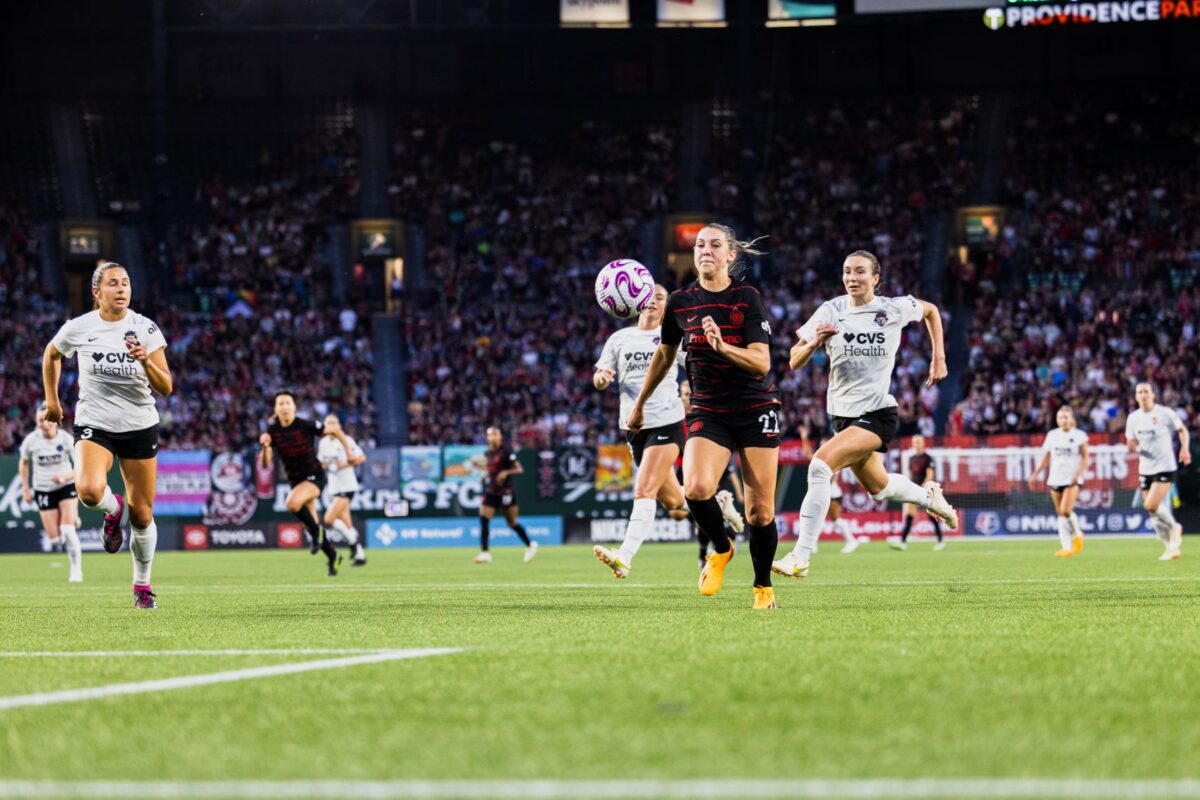The Portland Thorns played their first game with all five World Cup players back in the squad last weekend against the Washington Spirit in DC. The team was coming off of a much-needed victory where the team set the record as the first NWSL team to receive a first-half red card (awarded to Kelli Hubly) and win the game. Better yet, that game resulted in the Thorns taking three points off the North Carolina Courage, which was probably the biggest win of a game that included some insane ball control from Hannah Betfort for the equalizer and a Sophia Smith game-winner less than a minute into her return to Providence Park.
With momentum on their side, the Thorns travelled to DC to take on Mark Parsons’ title-contending Spirit. More so than most teams in the league, both the Spirit and the Thorns had players that suffered significant World Cup roster-related injustices. Sam Coffey and Ashley Hatch were inexplicable snubs, Crystal Dunn had to play in a non-natural position, Sophia Smith and Trinity Rodman were wingers in a system that isolated them and didn’t let them perform to the best of their abilities— the list goes on. With squads filled with players who were looking to prove their talents after a lackluster USWNT performance, tensions were always going to be high, and the match was set to be cagey.
Ultimately, a 1-1 draw was not what the Thorns wanted after dominating 4-2 in the earlier matchup, and the game was less tactically promising than it could have been. Let’s look at why, and how it may affect the Thorns as they head into the final stretch of the season.
The Thorns need to play to Betfort and Weaver’s strengths
The Thorns debuted their new 4-4-2 formation against the Courage and brought it out again in DC. As someone who has advocated for more defensive coverage with such advanced wingbacks all season, I am delighted at the success of a Rocky Rodríguez-Coffey double pivot. It provides much-needed stability for Portland’s backline, which was especially necessary with the Meaghan Nally-Emily Menges backline that Portland started due to Hubly’s red card. The Thorns held the Spirit to 0.62 xG, not including the penalty—very low for a team that has the attacking powers of Rodman, Ashley Sanchez, and Ashley Hatch.
While the new formation allows the Thorns to more effectively carry the ball through the middle of the pitch and have adequate defensive coverage, there was a disconnect between the eight midfielders and defenders and the two forwards. The Thorns only had 10 total shots, four of which were on goal, a shockingly low number for the team who has scored an average of 2.3 goals per game this season. The Thorns also only had 78 passes within the final third for a 53% passing accuracy, matching the eye test that showed the midfielders unable to find the feet of Smith and Morgan Weaver. In fact, the players with the highest number of completed passes throughout the game were the four defenders and Coffey. While it is important to be able to maintain possession in your own half, you need to be able to progress the ball up the field in order to win a game. The Thorns were unable to consistently do that against the Spirit.
The new formation seems to have been created around Smith and Morgan Weaver, who have great chemistry and the ability to change sides and seamlessly float in behind the back line. However, when Smith went down with what we now know is a mild MCL sprain in the end of the first half and the scoreline was still 0-0, the pressure was on for head coach Mike Norris to make some kind of formation or tactical change in order to grind out the win.
Betfort has been coming in for Smith all season and started in Smith’s absence at the World Cup. However, Betfort’s playing style is immensely different to that of Smith’s. Honestly, there is no player in the world who plays at Smith’s level, and it is unfair of Norris to slot Betfort into Smith’s position and ask her to do the same things, like receiving the ball with her back to goal and dribbling through multiple defenders to get a shot off.
Betfort is an out-and-out No. 9. Her ball control has improved immensely over the course of the season, as has her shot selection. However, she does not have the same dribbling control that Smith has (to be fair, no other player in the world does). A 4-3-3 is much better suited to Betfort’s strengths, where she can receive the ball in the box and use her physical strength to shoot it on target. A 4-4-2 where Betfort is up front with Morgan leaves less room for her to get good services into the box, and it’s not fair to expect Betfort to produce in a way that is not playing to her strengths.
Additionally, Weaver traditionally has done very well at tight angles, when she is able to cut in from the left side as opposed to starting centrally. Transitioning back to a 4-3-3, where she and Hina Sugita play out wide up top, will allow both players to cut in and threaten goal—a tactic that has historically worked well for both players.
The Thorns only had seven crosses throughout the entire game, compared to Washington’s 14. I would argue that the Thorns’ only good chance of the night came on Weaver’s goal, and in large part was due to Coffey’s excellent weighted ball behind the backline. Betfort, who played over 45 minutes, only had 17 touches on the ball, meaning that she was essentially boxed out of the game—largely was due to the formation. Reyna Reyes, who played only 15 minutes, had more touches than Betfort. In Smith’s absence the Thorns need to go back to a formation that allows their available forwards to succeed.
Bella’s command of the box is important
Despite failing to block Hatch’s penalty kick in stoppage time, Bella Bixby had a very good game. She had four saves on the night, but her real strength during the game was organizing the defense and being aggressive in the box. This season Bixby has become more aggressive off her line, stepping out to get crosses and long balls to mitigate shots before they even happen. A lot of the play in the NWSL is direct and over-the-top, inviting players to go one-on-one with the keeper. By coming off her line early, Bixby forced the Spirit front line to try a different route to goal, which they struggled with. Meghan Klingenberg and Natalia Kuikka were largely able to shut down Washington’s forwards’ attempts at running down the wings, and if they were able to get a cross off, Bixby was quick to track it down instead of waiting for the second ball.
These abilities are ones that should be valued by the USWNT, so hopefully Bixby gets called into an upcoming camp, as her play this season deserves recognition.
Hina is the GOAT
Honestly, I think Hina was the player I missed most during the World Cup break. Her work rate and ability to stick with the ball is unmatched. I don’t know how she manages to win some of the tackles she does, and her trickery on the ball is so much fun to watch. With Smith likely out until at least the playoff run, I would argue that Hina will be the Thorns’ most important player during the next stretch of games. They will need to utilize her strengths to float around the pitch wherever she pleases. Hina Hive let’s get loud!!


One reply on “Takeaways: Thorns 1, Spirit 1”
[…] I also wonder how much of it is up to tactics and the Thorns’ formation. As Jaiden wrote last week, it’s important for Norris to play to the strengths of the forwards he has available. In this […]